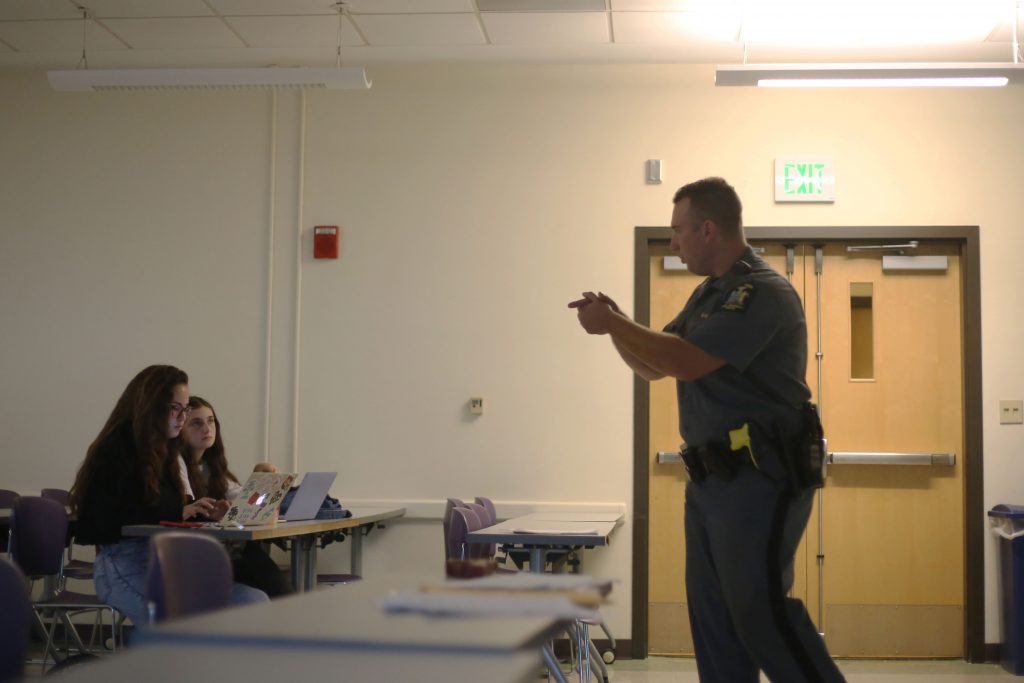Gunshots fired on campus is a sound no student hopes to hear. While many do not like to think or talk about the possibility of an active shooter scenario on campus, Binghamton’s New York State University Police (UPD) is providing training and resources through drills and alert systems in an attempt to enhance the preparedness of students and faculty.
In this year alone, there have been 404 shootings across the United States, according to Mass Shooting Tracker, a crowd-sourced database of active shooter situations. A mass shooting is defined as a single event in which four or more victims were shot, and in previous years, college campuses have often been targets.
In response to these numbers, UPD has launched a significant increase in preventative measures in recent years, including campus-wide violence prevention programs, efforts to identify troubled students and the creation of notification systems and refined response strategies to get law enforcement on the scene faster.
According to UPD Officer Richard White, the department hosts workshops on surviving active shooters to teach people how to respond in a mass shooting situation. The presentation and accompanying activities are held by UPD officers publicly several times each semester, and the workshop is also offered to student and faculty groups.
“In any given academic year, we give this presentation about 20 times according to the want and needs of students and faculty,” White said. “We want to give students an idea of what to expect and how to handle yourself during an active shooter incident.”
The training aims to enable the campus community to effectively handle dangerous situations with a clear mindset, so students and faculty can be better equipped to react with purpose in a mass shooting situation and maximize chances of survival.
Ryan Gennarelli, a UPD officer and firearms instructor, stressed the importance of recognizing a dangerous situation and following proper steps to increase safety. Officers discussed three options in an active shooter scenario: run, hide and fight.
The “run” option urges victims to find an accessible escape route, evacuate immediately and prevent others from entering the area. The second option, “hide,” applies to victims who cannot evacuate. In an active shooter situation, officers advise finding a place to hide that is out of the shooter’s view and silencing electronic devices. If you cannot run or hide, “fight” is the third option. Gennarelli stressed the importance of throwing a shooter off.
“The average SUNY response time is about three minutes, which means it is up to you to follow the proper steps to ensure your safety,” Gennarelli said. “If you are in this situation, you must do what you can to either get yourself to a safe location or make efforts to take the shooter out until law enforcement arrives at the scene. When we arrive, we ask that everyone comply to make sure we can remove the threat of the shooter as soon as possible.”
Rachel Moss, a sophomore majoring in English, has attended UPD’s mass shooting workshop in the past and said she worries because an active shooter scenario could occur anywhere, anytime.
“It makes me very upset that this is something people have to be prepared for and completely ready to go through because it could happen anywhere,” Moss said. “I know now that I would be prepared, but I can’t imagine how I would feel if I had no prior knowledge on how to act and what to do.”
While Binghamton University has never encountered an active shooter situation, past mass shootings have hit close to home. In April, Binghamton remembered the 10th anniversary of the Binghamton American Civic Association shooting in which 14 people died, including the perpetrator, and four were injured. Last week, SUNY Oneonta faced an active shooter threat from the hacked phone of a student — a threat that sent the university into lockdown. The student was not placed under arrest, and no charges were filed once she was located.
Gennarelli said there is no direct connection between the drills and what occurred at SUNY Oneonta and in Downtown Binghamton. Still, he cautioned students to keep in mind that shooting threats are real and prevalent in today’s society.
”We offer the same drill multiple times in a year and in almost every case, a student will question whether the drill is in regards to the recent shooting in ‘X’ place, and we want to remind them that we don’t want to create a sense of fear on campus,” Gennarelli said. “We want to train our students to be prepared if they were ever involved in an active shooter situation.”
Concluding this month’s round of workshops, UPD will host a session on surviving a mass shooting at 7 p.m. on Tuesday, Oct. 22 in University Union West room 325.



